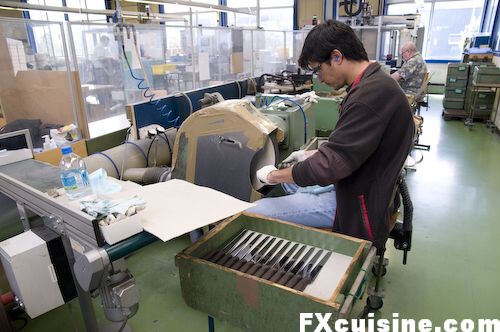Course:SPPH381B/TermProject/Chef Knife - Shirley Deutsch
A Chef’s Knife is a sharp cutting tool used in food preparation consisting of a blade that is attached to a handle. The blade is usually 20cm long and 3.8cm wide[1]. The blade style is French and has an edge that is straight until the end and then curves up to the tip. The handle is made of a combination of wood and steel.

Production Process
The blade is stamped meaning it is cut to shape directly from cold rolled steel, heat-treated and temper, then ground, sharpened, and polished. The blade of a chef's knife is typically made of carbon steel, stainless steel, a laminate of both metals, and ceramic[2].

Resource extraction: mined from the earth: iron ore, chromium, silicon, nickel, carbon, nitrogen, and manganese.
Primary manufacturing: The raw material is turned into sheet steel, each sheet the thickness of a knife. Steps: melting and casting, forming, heat treatment, descaling, cutting, and surface finish.
Secondary manufacturing: Plates of stainless steel to a knife. Steps: forging, tempering, Quenching, Profiling, Grinding, polishing, assembly, and packing. Transportation: loading, driving or shipping, unloading, warehousing.
Support infrastructure and power: construction building, warehouses, machines, and maintenance of machines, tools, equipment, trucks, etc. Road building.
Disposal/recycling: scrap metal recycling management. Landfill sorting.
Risk Assessment
Iron ore mining, Hazards might be:
- Iron ore dust (causing lung cancer)
- Diesel exhaust
- Handling iron ore in bulk carrier - iron ore liquefaction during sea passage – resulting in ships becoming unstable[3]
- Noise (causing hearing loss)[4]
- Vibration (damage to nerves and blood circulation)[5]
Cutting of stainless steel, Hazards might be:
- Hexavalent chromium dust and fume exposure (causes respiratory illnesses and cancer)
- Machine use accidents (causing injury or death)
- Lifting, carrying, dropping stainless steal (causing injury or death)
Assembly blade with handle, Hazards might be:
- Mishandling of the sharp blade (causing injury or death)
- Hot blade (causing burn injuries)
- Mishandling of tools (causing injury or death)
Truck driving, Hazards might be:
- Whole body vibration (causing back pain)
- Vehicle accident (causing injury or death)
- Maintenance of vehicle like repairs, flat tire, climbing or descending from high deck (causing injury or death)
Warehousing, Hazards might be:
- Storage and racking system (cause injury or death)
- Loading and unloading areas (cause injury or death)
- Slips, trips, and falls (cause injury or death)
Landfill sorting management, hazards might be:
- Machinery accidents (cause injury or death)
- Exposure to chemical and biological hazards (itchiness, irritations, injuries, death)
- Exposure to dust (causes respiratory illnesses)
- Repetitive stress injuries on hands, bank, knees, and fingers (causes Muskuloskeletal disorders)
Conclusion

A knife is a dangerous tool in the kitchen but is also a dangerous tool to make[6]. The production process of a Chef's knife is long and complicated and all starts with stainless steel. From this project I learned that objects creations are a lot more complex that one can image. There are so many steps in the process, each step is critical for its own reasons. Employers needs to watch out for their employees health and safety - and after reading this project I hope you can agree with me that making a knife is not a safe occupation. By enforcing and introducing controls, the workplace can be safer and lead to less exposure to illnesses, injuries, and diseases.
References
- ↑ Knife Manufacturing Process (n.d) Knife Manufacturing Process.Retrieved April 04,2017, from http://www.therias.com/pages/presentation/fab1_us.html
- ↑ Adam P. (2011, September) How Chefs Knifes are Made.Retrieved April 04,2017, from http://www.popsci.com/technology/article/2011-09/how-chefs-knife-made
- ↑ Bulk Carrier Guide (n.d) Iron Ore.Retrieved April 04,2017, from http://bulkcarrierguide.com/iron-ore.html
- ↑ Mary River Iron Mine to Produce dust, noise, and vibration (2011, September) Iron Ore.Retrieved April 04,2017, from http://www.nunatsiaqonline.ca/stories/article/1404112_mary_river_iron_mine_to_produce_dust_noise_and_vibration
- ↑ Mary River Iron Mine to Produce dust, noise, and vibration (2011, September) Iron Ore.Retrieved April 04,2017, from http://www.nunatsiaqonline.ca/stories/article/1404112_mary_river_iron_mine_to_produce_dust_noise_and_vibration
- ↑ Wikipedia (n.d) Knife Making.Retrieved April 04,2017, from https://en.wikipedia.org/wiki/Knife_making